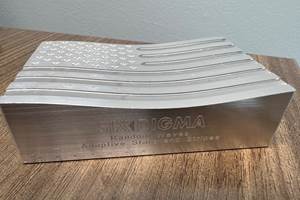Buying a Lathe: Slant-Beds and Multitasking Configurations
What are some variations on the basic lathe configuration? This can be helpful to review when considering the purchase of a new turning machine.
Share





When buying a turning machine, it can be helpful to be familiar with the various machine configurations available. Slant-bed lathes provide a number of advantages, while multitasking lathe configurations might open up possibilities heretofore unthought of.
Slant-Bed Lathes
The slant-bed lathe design is probably the most common and well-known configuration in today’s CNC lathes. Typically, the bed of the lathe slants at a 30- or 45-degree angle, although some 60-degree models also are available.
One obvious advantage to the slant-bed design is effective chip evacuation. Chips are simply washed into a chip conveyor or tray in the machine by the flow of coolant and the assistance of gravity. In high-volume production environments, evacuating chips quickly helps prolong the life of the machine by preventing them from accumulating where they may wear the machine ways or other moving parts.
Another advantage of slant-bed designs is larger X-axis travel. Unlike flatbed lathes in which the length of the guide rail is limited to the horizontal depth of the casting, the slant-bed design accommodates longer X-axis rails. This design also enables the slant-bed lathe to accept a larger part than a flatbed lathe with the same footprint.
Optimally, the headstock of a slant-bed lathe is mounted on the bed and shares the same 30- or 45-degree angle, parallel to the X axis and traveling on the same plane as the linear axes. Less-expensive models may be constructed with the base of the headstock at zero degrees (flat on the base and not slanted). This design makes the machine harder to get back in operation after a crash.
Multitasking Lathes
Multitasking machines are often built on a turning center platform. These machines use rotary tools to combine several cutting processes such as turning, milling, drilling, tapping, grooving, threading and deep-hole boring on one machine. It is not necessary to have multiple machines to handle those operations separately. Typically, multitasking turning centers have a second main spindle or an additional subspindle to which the workpiece can be transferred automatically from the first spindle. This enables continuous and simultaneous machining of first and second operations. The second spindle can grab the part for work on its back side to complete the part in one setup.
When a subspindle is used in conjunction with a bar feeder, the subspindle grabs the end of the bar and pulls out the length needed for the next part. The subspindle is more precise in pulling out the stock than the bar feeder is pushing it in.
After the parting tool severs the finished part, the subspindle can then drop it into the parts catcher while the main spindle begins machining the next part. The value of the parts catcher cannot be overstated as a reliable method for removing the finished part from the subspindle to make room for the next part.
With automatic subspindle workpiece transfer, a three-jaw or dead-length collet chuck is required. You don’t want a chuck or collet that may move in or out slightly to push or pull on the workpiece when clamping. This unwanted motion can easily mar the workpiece.
There’s virtually no limit to the variety of multitasking lathes that provide innovative part-processing combinations and superb performance. Twin main spindles and dual-turret configurations are two examples. It should be noted that it may be necessary to have separate part programs that can run simultaneously, each synchronized to avoid a collision. Shops that are new to the concept of multitasking on a lathe may not realize that new programming software and additional programmer training may be required to support these machines.
This is part four of a four-part series about buying turning machines.
- Part one: Buying a Lathe: The Basics
- Part two: Buying a Lathe: Turrets and Live Tooling
- Part three: Spindles and Tailstocks
Find more insights about acquiring a new machining center by visiting the Techspex Knowledge Center, “.”
Related Content
Custom Workholding Shaves Days From Medical Part Setup Times
Custom workholding enabled Resolve Surgical Technologies to place all sizes of one trauma part onto a single machine — and cut days from the setup times.
Read MoreIndustry Analysis: Machining Semiconductor Components
With many machine shops anticipating long-term growth in demand from the semiconductor industry, it is worth the time to heed the advice of manufacturers who have already been servicing this end-market for years.
Read MoreBuilding Machines and Apprenticeships In-House: 5-Axis Live
Universal machines were the main draw of Grob’s 5-Axis Live — though the company’s apprenticeship and support proved equally impressive.
Read MoreMachine Tool Drawbar Made With Additive Manufacturing Saves DMG MORI 90% Lead Time and 67% CO2 Emission
A new production process for the multimetal drawbar replaces an outsourced plating step with directed energy deposition, performing this DED along with roughing, finishing and grinding on a single machine.
Read MoreRead Next
Machine Shop MBA
Making Chips and 91ÊÓƵÍøÕ¾ÎÛ are teaming up for a new podcast series called Machine Shop MBA—designed to help manufacturers measure their success against the industry’s best. Through the lens of the Top Shops benchmarking program, the series explores the KPIs that set high-performing shops apart, from machine utilization and first-pass yield to employee engagement and revenue per employee.
Read MoreAMRs Are Moving Into Manufacturing: 4 Considerations for Implementation
AMRs can provide a flexible, easy-to-use automation platform so long as manufacturers choose a suitable task and prepare their facilities.
Read MoreLast Chance! 2025 Top Shops Benchmarking Survey Still Open Through April 30
Don’t miss out! 91ÊÓƵÍøÕ¾ÎÛ's Top Shops Benchmarking Survey is still open — but not for long. This is your last chance to a receive free, customized benchmarking report that includes actionable feedback across several shopfloor and business metrics.
Read More





















